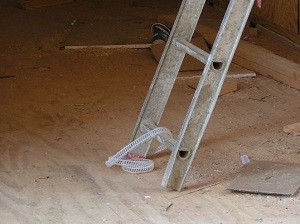Ladders are involved in 20% of fall injuries among workers and 81% of construction worker fall injuries. The inspection of the extension ladder is a very important step to avoid serious or even deadly injuries. OSHA requires that employers ensure ladders are inspected on a periodic basis. However, even with periodic inspections, it is still every worker's responsibility to be sure that the ladder they are about to use is in safe working order.

OSHA Construction Standard 1926.1053(b)(15) Ladders shall be inspected by a competent person for visible defects on a periodic basis and after any occurrence that could affect their safe use.
OSHA General Industry Standard 1910.23(b)(9) Ladders are inspected before initial use in each work shift, and more frequently as necessary, to identify any visible defects that could cause employee injury.
Everyone knows that safety training is crucial to the health and welfare of the workforce. But common sense type safety topics don't always make it into the safety meeting discussion. Do not assume that employees have the same knowledge that you do and do not take common sense for granted. Make sure the basics are covered, like ladder inspections, on a regular basis. Employees may not ask or speak up about something they think is "a stupid question" and they don't want to risk embarrassment in front of their co-workers, so they may take an unsafe action without knowing it. The easy fix is to have regular safety meetings (even if they are only 5 minutes long!) on the simple stuff too.
When planning a safety meeting or safety moment about extension ladder inspections, don't forget to emphasize these important points.
Always visually inspect ladder feet to ensure that foot pads and feet assembly are present and in safe condition. Damaged or missing feet pads can cause you to slip or lose balance and suffer a deadly fall.

- Inspect the rungs, rails, lock (dawgs), rope, and pulley assembly of an extension ladder and be sure that all parts work properly.
- It is very important to make certain that the rope and pulley are working and that the ladder locks (dawgs) do not slip!
- Never attempt to repair a ladder! Do not use wire, screws, bolts, duct tape or electrical tape as a way to fix any ladder; instead, tag it and remove it from service.
- Ladder inspections should include making sure that labels are readable and haven't been painted over or damaged.
- Check the rungs and steps for mud, grease, or dirt to avoid potential slip/fall hazards.
- Follow the manufacturer's recommendations for proper inspection and use of the specific ladder.
- Remove any ladder from service that is found to be defective!
- Never use a step ladder (in a folded position) as an extension ladder!
.jpeg)

